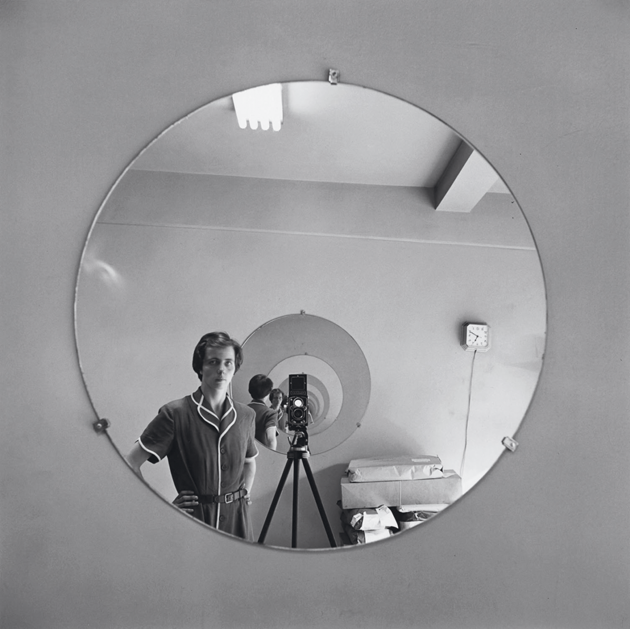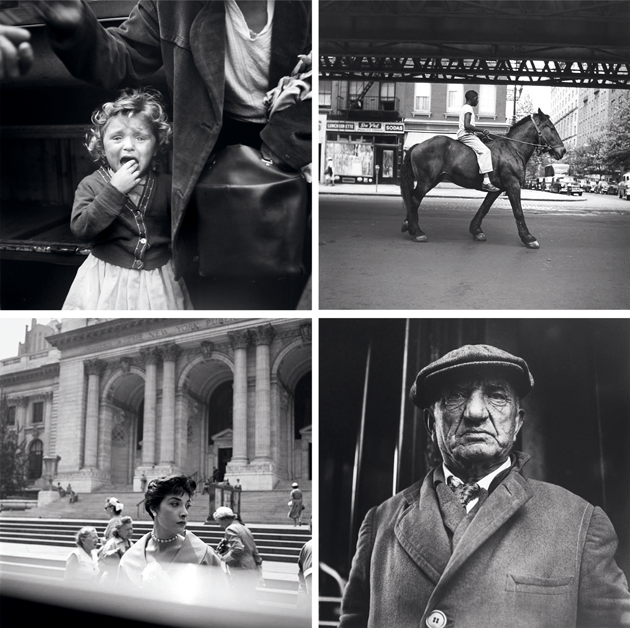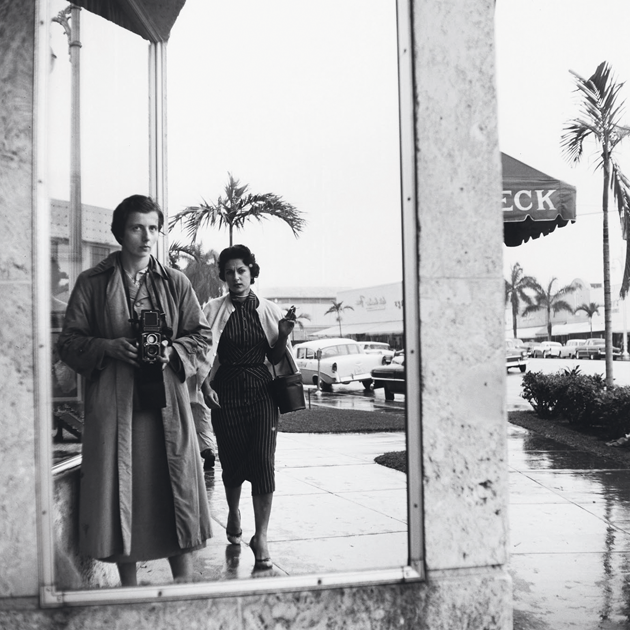Dear Miss Maier (for who would dare address you as Vivian, let alone Viv?),
Inevitable that I should get crushed out on you, I guess. You seem to be everywhere these days — at least everywhere in my house. On the coffee table, in my study, glowering up at me from the pile of books on the floor at my bedside. You’re wearing your classic 1950s “roaming street photographer” outfit: loose gingham shirtdress (for summer) or tweedy Chicago winter coat; floppy beret or otherwise shapeless hat; men’s shoes; the old-fashioned boxy camera slung louche and low from the leather strap round your neck. Add to these — for Eros demands I must — the unkempt, sometimes elfin-looking hair; the large hands and downward-drooping mouth; the calm, cogent, ever so slightly cruisy look in your Rolleiflex eyes. All of which is to say I’m a monster fan — that I own every one of the high-gloss tomes devoted to your work (six now) published since 2007, when you and your breathtaking oeuvre were discovered in one of the great lucky grabs in the history of photography. Yes, I realize you’re dead. Nonetheless, with all girlish respect, might I say that I think you’re hot?
Yours, blushingly,
The Author
Can there be anyone yet unfamiliar with the beguiling Vivian Maier, nanny-photographer for the ages? So often now has her story been circulated — especially among the latte–lapping, Salon-surfing, NPR-listening crowd — that it might seem unlikely. But here’s a quick refresh anyway — not so much for the benefit of stragglers but for those (myself included) infatuated with the lady in what will no doubt be called an unnatural if not prurient Humbertina Humbert–like fashion. Expel from your mind any lingering images of the chewing gum, short shorts, and 1950s pink lipstick of the original Lolita, vulgar Dolores Haze. Welcome instead lanky Miss Maier, a camera-lugging Lo — serious, shy, yet seductive still, in ginormous clodhoppers and draggled old-maid skirts.

“Self-portrait, May 5, 1955.” All photographs © Vivian Maier/Maloof Collection. Courtesy Howard Greenberg Gallery, New York City
Indeed, get yourself up to date: it’s 2007. John Maloof, a twenty-something Chicago collector and urban-history buff, buys several boxes, contents unknown, at an auction of items left unclaimed at a local self-storage company. The boxes, for which he pays less than $400, turn out to hold roughly 30,000 negatives, some prints, and innumerable rolls of undeveloped film. Maloof finds that most of the images are candid shots or close-ups of people on the streets of Chicago, New York, Miami, Hong Kong, Bangkok, and elsewhere, taken between the 1950s and the 1980s. The subjects are marvelously diverse: working men, cops, squalling babies, querulous society matrons, African Americans (many), newspaper vendors, suburban kids, middle-class lady shoppers, bathers in Lake Michigan, and a fairly pungent assortment of the poor, the drunk, and the deadbeat. There are also pictures of animals (alive and as roadkill), fallen leaves, ownerless shoes, homemade signs, leaking fire hydrants, junk abandoned at curbside. And there are a number, too, of what appear to be self-portraits, artfully framed using mirrors, plate-glass windows, and other reflective surfaces. These show a tall, strange-looking, crane-like lady of indeterminate age. Sometimes we see her shadow only. The photographer isn’t making the usual hobbyist’s gaffe here; the silhouette is the subject — part of a stringently composed (and stark) visual allegory.
Though not a photo historian, Maloof realizes the importance of his find and buys up negatives and film rolls acquired by another collector at the original auction. (He will ultimately own about 100,000 images, plus great wodges of Maier memorabilia; Jeffrey Goldstein, Maloof’s main rival in the Maier-print-selling business, owns around 17,500.) After some research Maloof identifies the mysterious woman as Maier, a reclusive French American who worked for most of her life as a live-in nanny for various prosperous families in New York and Chicago. (In a poignant twist, the eighty-one-year-old Maier is still alive and living by herself in a grotty Chicago flat at the time Maloof acquires her negatives, but he doesn’t find this out until he sees a short newspaper obituary after her death in 2009. Like Henry Darger, her fellow Chicago outsider artist, Maier died not knowing that anyone would ever see her life’s work.)
As soon as Maloof puts her images online, Maier’s story goes viral. Astonishment builds. Journalists around the world hail “the best street photographer you’ve never heard of”; she is compared with Diane Arbus, Robert Frank, Helen Levitt, Weegee, Garry Winogrand, Richard Avedon. Living-master shutterbugs — Mary Ellen Mark and Joel Meyerowitz among them — weigh in on her stunning shot-framing ability, her perfect timing, and her commanding apprehension of urban space and its denizens. The art world is likewise abuzz: after two exhibitions of Maier’s work in New York in 2012, Roberta Smith, the Times art critic, declares her a virtual shoo-in for “the pantheon of great 20th-century street photographers.”
New biographical details emerge. The French background is clarified: though born in New York in 1926 — to a French domestic servant and an Austrian-immigrant father (he left when Maier was still an infant) — the photographer spent her early years with her mother in Saint-Julien-en-Champsaur, the mother’s ancestral village in the French Alps. Maier returned to New York in 1938 as an adolescent and lived there — apart from several return visits to France — into her twenties. No one knows how she acquired her camera skills.

Clockwise from top right: “Grenoble, France, 1959”; “New York, NY”; “New York, NY, May 1953”; “New York, NY”
By the mid-1950s, Maier was working as a nanny in Chicago. Various former charges, now middle-aged adults, remember her fondly enough: in Jill Nicholls’s BBC documentary, Vivian Maier: Who Took Nanny’s Pictures? (2013), and Maloof’s film, Finding Vivian Maier (2014), several reminisce about her in positive but frank terms. Everyone recalls the old-world formality, the peculiar Franco-American accent (some thought it faked), the absence of friends or family, the paranoid obsession with privacy (in none of the family homes in which she lived and worked would Maier let anyone enter her room), the forcible, usually left-leaning political opinions, and the irascible, sometimes violent, temper. One female interviewee describes her, somewhat enigmatically, as “abusive.” Some say she was mean. Others found her calm, likable, and even inspiring in her irritable, oddball way.
What’s most baffling, of course, is that Maier never shared her photography habit with anyone. None of her employers seem to have noticed the picture-taking monomania, or the hundreds of boxes of film squirreled away in her shut-to-the-world living quarters. The children were half-aware: Maier shot even while pushing kids around in strollers to playgrounds, parks, and more far-flung places of interest. (Maier often showed her little charges Skid Row and the dodgier parts of town; she took one girl to the stockyards to see the abattoir in operation.) If indeed an outsider artist of some sort, Maier was very much an insider too: possessed of a spooky, secret-agent-like deep cover.
Alas, Maier’s lifelong furtiveness — she died intestate, without friend or kin to organize her confusing affairs — has had at least one grim consequence: the small nuclear war that has erupted over the rights to her images. (“The Vivian Mire,” one critic calls it.) Millions of dollars may be at stake, and the legal complications — involving convoluted estate laws in both France and the United States — are bewildering. Maloof has been printing and selling Maier’s works through a New York gallery for thousands of dollars each, but a recent claimant, purportedly Maier’s closest living French relation, vehemently contests his right to do so. Given that the court battles might go on for years, as the New York Times recently reported, Maier’s photographs may soon be embargoed and withdrawn from public view until the mess is clarified.
What’s a Humbertina to make of it all? In the pitched battle over Maier’s work one sometimes feels, paradoxically, that the photographer herself has become obscured: visible only notionally and unimaginatively, either as dreary female stereotype or cipher in a mackintosh. In the BBC documentary, the photo scholar Pamela Bannos complains bitterly about Maier’s “fractured archive” and the vaguely sordid all-boy scrum over her legacy. Dollar signs — like floaters — seem to be in everyone’s eyes. Yet Bannos is even more critical of the way Maier’s male admirers have caricatured her as a kind of damsel in distress in need of posthumous rescue by chivalrous photo-daddies. She’s right: some Maier boosters treat the photographer with a sentimentality bordering on the treacly. (“Her photographs,” writes one recent critic, were like the children she “helped to nurture and who would ultimately venture into the world on their own.”)
Such cloying depictions seem at once tedious and puerile, and never more so than when one looks at the pictures, scores of them, that Maier made of herself. In their rigor, dark wit, and visual intensity, Maier’s self-portraits are the most intriguing part of her work. (Maloof devotes a stern and beautiful volume to them.) None of the various goofy stereotypes projected onto her — Mary Poppins with a Rolleiflex; frail spinster-genius à la Emily Dickinson; frumpy victim-beyond-the-grave of grifters — match up with the brisk, eagle-eyed, no-nonsense, and frequently intransigent figure who, even as she broods on her own reflection in the glass, also seems — uncannily — to stare right at us.
Granted, in many of her self-portraits Maier is more figment than fully enfleshed: a small bent-over blur reflected in a 1950s chrome hubcap. The effect, however, is considerably more menacing than self-effacing. (Interestingly, she frequently smuggles a reflection of herself into her shots of middle-aged women, frequently shoppers, who remain noirishly unaware of her presence.) Elsewhere, by contrast, Maier is front and center, half-smiling, or staring with chilly aplomb. She often looks like she hasn’t washed her hair, or even combed it, for weeks. But she also looks like she doesn’t care. The self-confidence is aggressive — almost regal. So it’s odd that among the rivals now contending over her treasure, so few have mentioned this androgynous poise and ferocity.
Nor has anyone, I surmise, commented yet on how sexy Maier is — at least to those of (dare one say) unorthodox erotic tastes. In my standard-issue, hopelessly artsy-fartsy little crowd of San Francisco lesbians, she is commonly assumed to have been one of the girls on the bus. “A dyke, for sure,” says a friend. “Look at that guy’s shirt.” “Berenice Abbott with bedhead,” says another. “Freaky hot!” intones a chorus of voices from the Heights of Bernal. Current research suggests that Maier never had a romantic partner of any description. But an elusive L-word nimbus nonetheless hovers around her. Among the images in Maloof’s latest megavolume, Vivian Maier: A Photographer Found (2014), is a never-before-seen 1954 picture of Maier — pimply, Buster Keaton–ish, severely buttoned up in a dorky overcoat, and sporting a resplendent black eye. She seems to feign world-weariness. I find the boyish self-possession at once comic, campy, and irresistible.
Am I suggesting that Maier might have been homosexual? That this (boo hiss) is the aspect of Maier people aren’t seeing? Not exactly. Marvin Heiferman, a contributor to the new Maloof book, writes that Maier persistently avoids the “note of grace and femininity” usually associated with women photographers and their work. This is an exceedingly ladylike way of putting it; street slang might be more evocative. Could one perhaps describe Maier as “queer”? (Even “queer as a three-dollar bill”?) “Queer” is not a word I’m especially fond of, but I’ve come to think of it as a permissible place-saver for Maier precisely because it manages to insinuate something titillating and illicit but at the same time ill defined. (It also has a nice 1950s pulp-fiction ring to it.) It’s far more suggestive than “spinster,” yet not, perhaps, as boorish or reductive as “lesbian” or “dyke.” With Maier, it has an associational bonus: in certain photos she looks “queer” in the archaic sense — eerie, fey, an adept in arcana, witchcraft, magic mirrors, the secret glass world behind ordinary appearances.
Still, it’s early days in Maier scholarship, and in the absence of biographical information, one must remain circumspect about any lurking queerness in the persona. My current preferred term for Maier is one I’ve evolved with her specifically in mind. The French feminist Monique Wittig once declared: “I am not a Woman; I am a Lesbian.” Whatever else Maier may have been, she was not exactly a Woman either. Safest to characterize her, perhaps, as a Not-a-Woman, or even Non-Woman for short.
Maier’s Non-Womanness registered most forthrightly in her near-complete refusal of any signifier — sartorial, cosmetic, behavioral — that might feminize her in a viewer’s eye. The only tokens of womanliness she seems to have tolerated were those conveyed in her low-stakes “female” occupation: there, she might masquerade, unobtrusively enough, as a “woman caring for children” or a “woman pushing a baby stroller.” The camera was the only incongruous element in her performance.
The austere self-presentation suggests Maier’s extraordinary moral and physical toughness and, one suspects, a breathtaking carnal indifference to men. (With the men and boys whom she chose to photograph, she seems to have found a friendly, fleeting, desexualized camaraderie.) The refusal of femininity was crucial to her art. At some point, one supposes, Maier had simply jettisoned her weakness, the female thing, and it fell away from her, like dross.

Clockwise from top: “Self-portrait, Chicago, August 1977” (detail); “Self-portrait”; “Self-portrait, 1955”
Until very recently, Non-Women like Vivian Maier have barely registered as human, let alone as a creative constituent force in modern life. Men usually don’t pay much attention to Non-Women — unless, that is, they find themselves competing with one or require her help. The “girly-girl” female will likewise shun or pretend to ignore her — at least until advancing age and a concomitant loss of “feminine” charms render said girly-girl a Non-Woman too. But one could say a great deal here about the role of Non-Women in modern civilization — their ingenuity and dash, their huge yet insufficiently appreciated contributions to literature, the arts, film, theater, politics, the social sciences, medicine, science, exploration, warfare, sports, and journalism.
Yes — Non-Women of the liberated era have often been lesbian, queer, what-have-you, and self-consciously so. Yet Non-Women don’t really have to be anything, libidinally speaking, to flourish. Many Non-Women have succeeded, for example, at the highest levels of politics and statecraft: Eleanor Roosevelt, Golda Meir, Indira Gandhi, Margaret Thatcher, Condoleezza Rice, Angela Merkel, Hillary Clinton — all erotically masked and asexual in style. Maier may have been similarly opaque and uncategorizable. Curiously, Non-Women have especially distinguished themselves as serious photographers — some of them unquestionably lesbian or bisexual (Claude Cahun, Gisèlle Freund, Annie Leibovitz, Catherine Opie), others less glibly defined (Florence Henri, Imogen Cunningham, Eve Arnold).
Were I to rave on unchecked, I’d be tempted to describe Vivian Maier as the most seductive incarnation of the Non-Woman in recent cultural memory. The dignity combined with genius is virile and magnetizing. Phobic about intrusion — or was it simply her noble reticence? — Maier hid all she valued most deeply: the drama and beauty she observed in the everyday world; her insatiable framing of instants in other people’s lives; her own hardly quotidian allure. She was waiting for us to find her, perhaps, to get her in focus. Now that we have — Tut’s secret chamber stands open, revealing the heaps of gold — it’s intoxicating. Like joyful marauders, we take our selfies, mug for the camera, and proceed to ransack the nanny’s thrilling hoard.







































































































